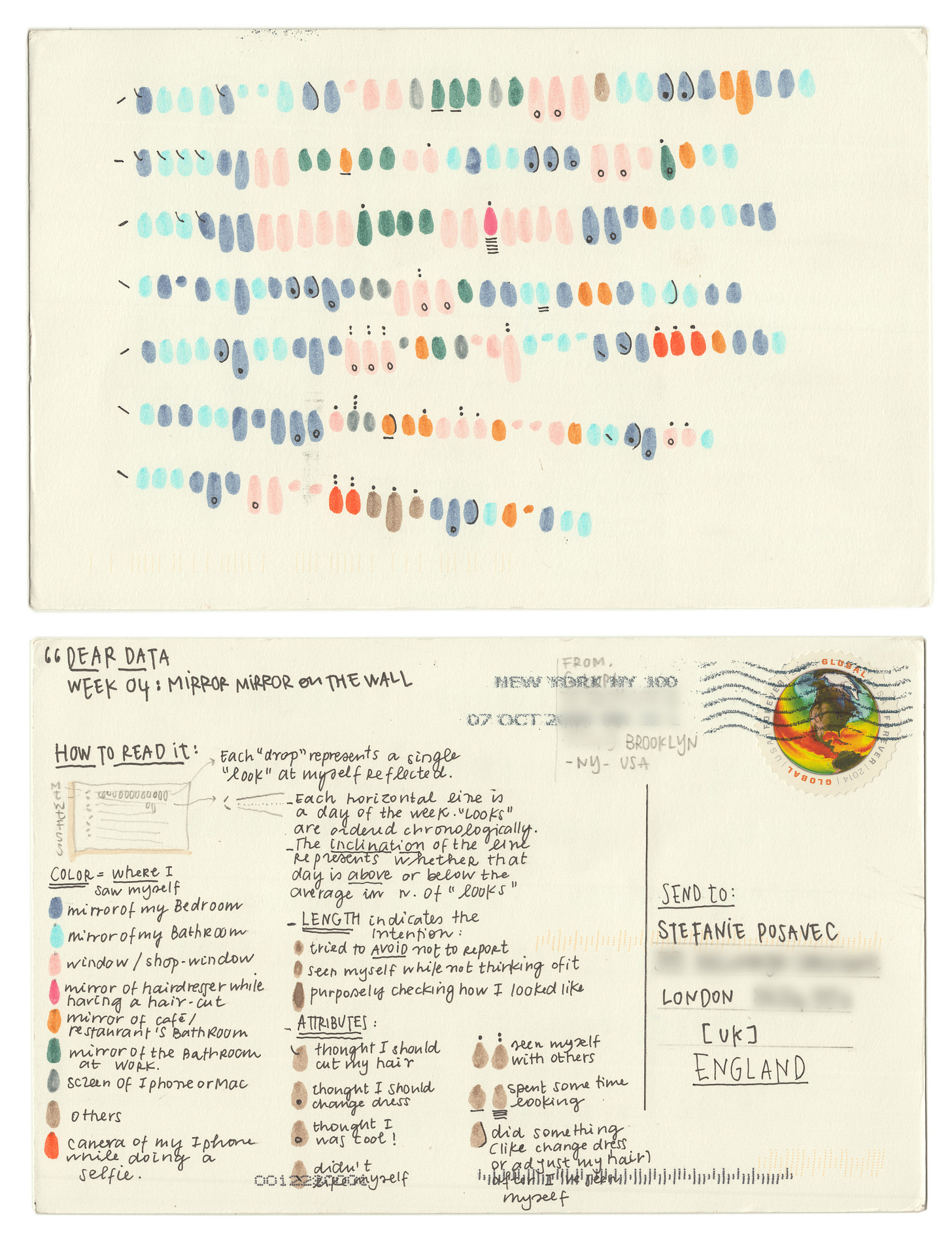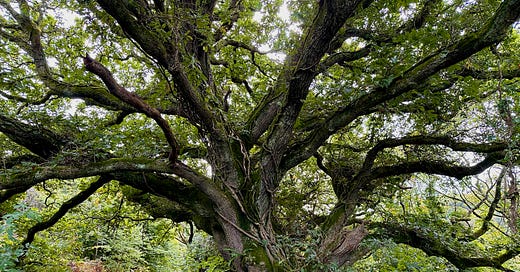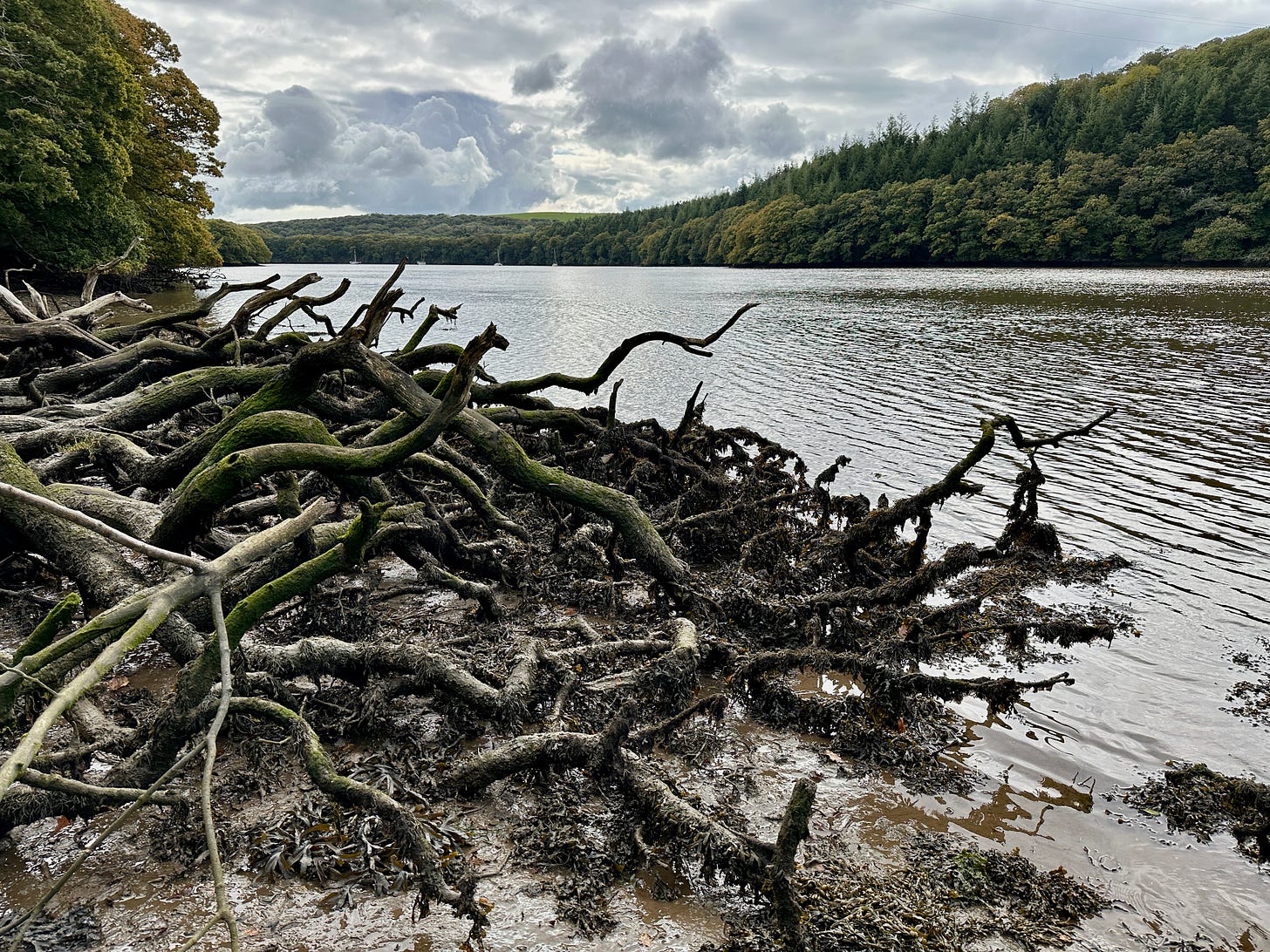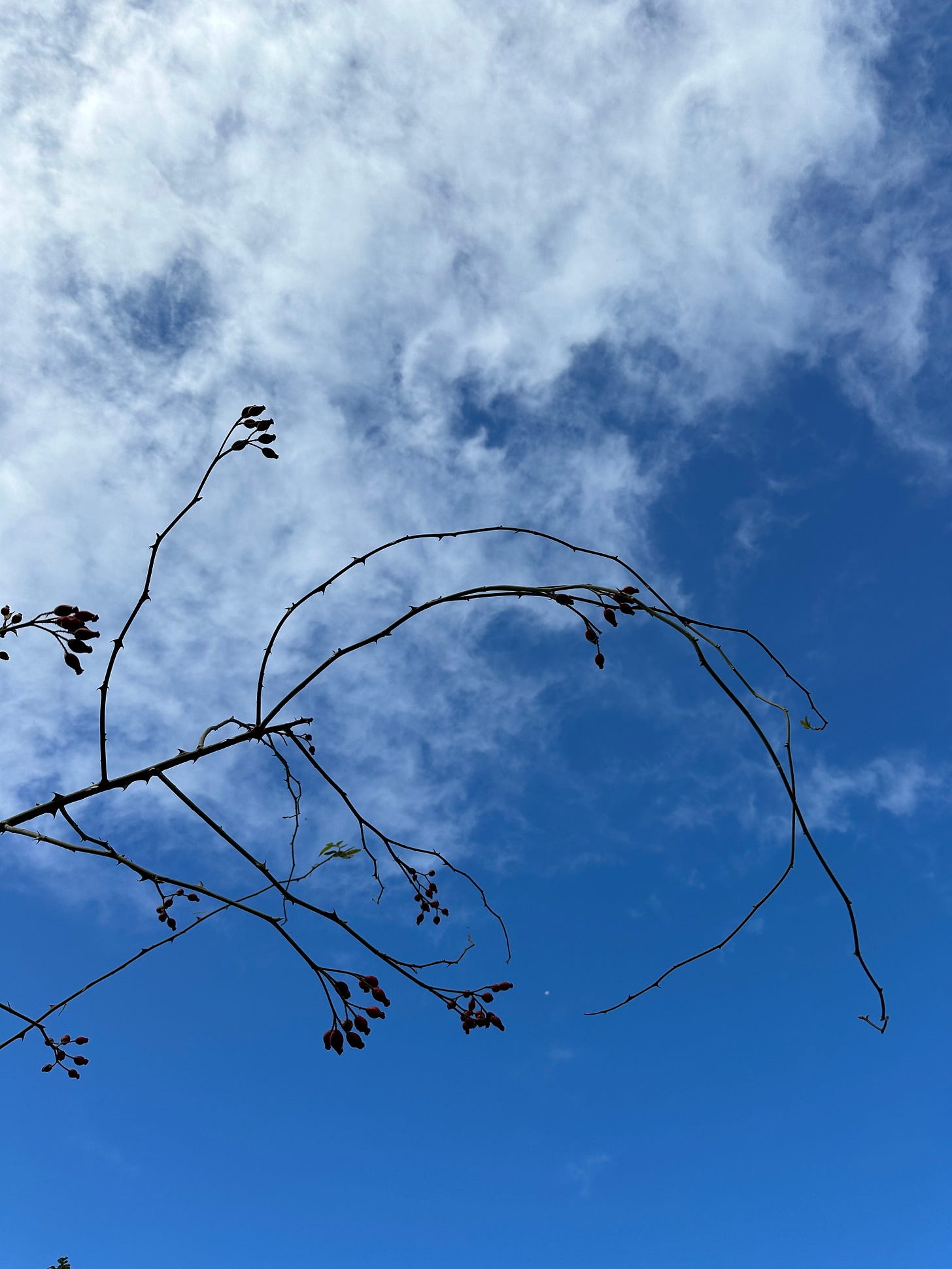I spent a week at a retreat this month. Not a retreat that I was planning or facilitating, but one that I was simply attending.
I didn’t know anyone at this retreat for writers, and showed up a day late, the result of tight schedule that involved teaching a three-day workshop/retreat right before. My fall calendar felt very back-to-back, and I had debated on whether or not I should even go.
It was a plane, train, and automobile situation to get to the stunning property at the edge of Cornwall. When I finally arrived, it felt a bit awkward to step into a group that had already had a day to get to know each other. Would I fit in? Would anyone like me? Would they already have a bunch of inside jokes I didn’t understand?
You know what’s good for keeping a little social anxiety at bay? The haze of jet let. I was too tired to care.
I had forgotten how restorative and energizing it is to be together with people who also feel like they spend much of their time in their own heads. People whose artistic lives and inclinations can sometimes seem to complicate making connections with people outside of their creative spheres. People who feel a little removed, like they’re on the edge looking in, but also who deeply crave to be seen and understood.
The energy of that week settled into my body at a cellular level. Perhaps it was a bit similar to the intensity of early days of love, when you want to stay up late talking all night long. Except in this scenario, everyone drinks herbal tea and goes to bed around nine or ten, and then gets up in the morning and sits in silence for an hour.
A few days after the retreat I found myself sitting on the train feeling what can only be described as incredibly giddy. As if I was all of a sudden going to explode out of my seat and run up and down the aisles yelling, “I HAVE NEW FRIENDS! I HAVE NEW FRIENDS!”
Instead I sat quietly and sent everyone WhatsApp messages trying to play it cool.
A writer I know who leads retreats once told me that at the end of them, when people tell her what a magical, special time they had—how absolutely incredible and unique their group was—she resists the urge to respond, “this one wasn’t that special, they’re all like this.”
That’s kind of a downer to hear when you’re fresh off taking part in something that has in fact felt incredibly special, but I worked as a camp counselor for many years, and I know this drill. You can create a container for magic, make people feel safe and taken care of, gently encourage them to share what’s at their core. When you do, really powerful things can happen.
That’s not to say that every retreat I have ever done has gone seamlessly. Certainly some groups gel together better than others, but there’s something powerful in knowing that it’s not all just up to chance.

The internet abounds with lists of tips for “how to make friends as an adult,” digital proof of how much we’re all craving connection. The friendship dip is real, relationships feel like admin, and we barely know how to just hang out with one another anymore. It feels incredibly difficult to connect.
I feel this too—regularly—but there is one thing that I have found which makes building friendships easier: art and creativity.
Art is how we express ourselves and the creative pathway offers a direct line into the core of who we are. We feel seen. We feel understood. We’re reminded that we’re interconnected with a kind of creative mycelium. Above all: it’s a surefire way to get to know someone.
It doesn’t even need to be creative work you’ve made yourself—a conversation about a certain book you like, music you listened to lately, or a piece of art you saw, tells something about yourself. It offers someone else the potential of a strong connection point, or even just a passionate discussion because they feel entirely different. That’s the power of book clubs.
With that in mind, the past few years I’ve worked at being more intentional about carving out time and space for deeper friendships centered around creativity, what I like to call “creative cohorts.” Using art and creativity as the container for gathering.
Largely, this is because as I step into middle age, I find myself craving the sense of openness and possibility that seemed to abound in my earlier years before we were all too confronted by the constraints of adult life.
These days, it feels like much of socializing is mostly centered around complaining about the mundane aspects of everyday life: the house projects, the health issues, the constantly underlying sense of dread and anxiety that modern life seems to always have on offer. If there’s a spark of something—of passion, of discourse—it’s usually around politics, which also results in complaining and feeling overwhelmed.
Those topics will always be on the table, but I also crave something more generative. A container in which something is built together, in which we’re supported to stretch for our creative edge, in which connections are made not just over what is, but what is possible.
Priya Parker writes in The Art of Gathering: How We Meet and Why It Matters:
“Reverse engineer an outcome: Think of what you want to be different because you gathered, and work backward from that outcome.”
Reverse engineer creative magic!!! Enter the creative cohort: various groups and gatherings centered around creativity.
All friendships, cohorts, and gatherings look different, so this isn’t a step-by-step list of how to have them, but I wanted to share a few different ways that creative cohorts show up in my own life, in the hopes that maybe they inspire some in yours.
In-Person Creative Cohort
Together with some friends, we came up with “Creative Salon,” a loose gathering of three creatively-minded couples. We were attempting some modern version of 1920s salons à la Gertrude Stein, craving a need to connect over our various creative mediums, outlets, and interests.
We get together on a roughly every-other-month basis, mostly because coordinating six schedules is difficult. Everyone is encouraged to bring either a project to share or a creative conundrum that they want help with, and we begin by pulling an Oblique Strategies card because, of course. Then we all get about 15-20 minutes each to share. This format has led to excellent ideas and many seeds of projects, but above all, I feel a sense of support, and a sense of feeling at home—with them, and in myself. I get to show up as I am, and be met by people who do exactly the same.
Virtual Creative Cohort
I am part of a group of four Substack writers. I have yet to meet any of them in person, but we have a monthly Zoom to talk about writerly things, and dare I say it: this has made us friends. We don’t have a strict structure to these calls (everyone’s a writer, so we’re all pretty good about asking each other questions), but it’s a time to check in with how we’re all doing, ask for advice, brainstorm ideas, or just complain for a bit. I don’t know that I would feel as good about writing this newsletter without it. In fact I asked them if writing a piece about creative cohorts was a good idea, and they said yes.
I also have an artist friend who I do the occasional “virtual fika” with. Usually involves coffee and chatting while we do some drawing in our sketchbooks. Casual and fun.
“Some people go to priests; others to poetry; I to my friends, I to my own heart.”
-Virginia Woolf, The Waves
Creative Cohort Immersion
Obviously the magical thing about a retreat is that you get several days away from everything else and get focused time together. This kind of time and space can feel elusive, but I’m a believer that with some work and planning, you can create and host your own.
For example, the past couple of years I have been invited to a weeklong gathering called “Friendsidency.” This had started from the desire of a few friends to recreate the energy they had felt together in college, a time when intellectual and creative passions ran high, and everyone had big projects to work on.
The idea was simple: get together for one week in one place, come to work on a project or do whatever needed to be done for creative restoration, gather in the evenings and share about it. Kind of like a residency, but you know… with friends. I wasn’t part of that initial group, but feel incredibly grateful for having made the cut to join in as an outsider. The week is loose in nature, but it’s structured in a way that people all take part. Everyone is in charge of either making a meal, or helping with a meal, as well as signing up for dish duty. At the end of the day there is a sharing time, so everyone can get feedback on what they’re working on.
It’s a great example of “working in solitude, together,” and has made me think about other ways that I could gather friends or creative acquaintances together for a chunk of time devoted to creativity.
Creative Cohort Projects and Collaborations
One thing about being a working artist and writer, is that people will usually take you seriously about engaging in creative projects because it’s seen as your “job.” Thanks to our extreme productivity culture, it’s a lot easier to ask “hey, want to collaborate on this creative project for work?” than “hey, want to collaborate on this thing just for fun?”
I think we need a hell of a lot more “just for fun” collaborative projects, but I also know that the structure of doing something for work can be helpful (deadlines and all that).
In my creative ecosystem I have lots of professional collaborations like my lunar calendar with Roshni Robert or the Harmony of Opposites workshop that I hosted with
earlier this year.But I also have personal ones. A friend and I will sometimes send each other an essay prompt—basically some question or topic we’ve been thinking about lately. We give each other a deadline and then send a draft. They’re never polished or finished, which is part of the fun.
Another example: doing prompts with a friend and checking in with each other along the way.
Professional Creative Cohort Support Team
Working artists and writers need generative spaces, but sometimes, we also just need to commiserate. A place to complain about all those pesky self-employed, artist, and creative things that other people just don’t understand. I’m looking at you taxes and bookkeeping!
Those logistical components of running your own creative business are one thing, but you also want someone who can help you deal with the emotional load. Like the fact that sometimes you just hate absolutely all of your work and that’s ok (at least temporarily). Or someone who will remind you that, yes, you can write this book and you will. Someone who is on standby for your existential artist crisis texts. Someone who will tell your work is worth it and you should definitely charge more. Someone who will remind you to celebrate small wins.
Above all, someone who you can bounce ideas off of and brainstorm with. Every idea needs a little breathing room, and if they only sit in the stuffy, closed-up space of our own minds they won’t get it.
But you know what? I think you need these things even if you’re not a working artist or writer. It’s a way to take our creative practice seriously, to show that we honor it by giving it the support system that it needs.

The lie we so often tell ourselves is that art can be made alone.
Solitude is a part of the process, but it is not the whole process. We may need to retreat to the studio or to the desk to quiet the outside world and get our work done, but that is only facilitated by knowing that there’s a supportive structure of connections around us.
We want to be part of a club. A crew. A cohort. Something that makes us feel a little less alone, something that makes us feel like we belong.
I like to think of these various versions of cohorts as forming a creative constellation. A web of connections and grounding points. One that supports, but also one that inspires.
A constellation that feels like home.
-Anna
I would love to hear about what kind of creative cohorts you have in your life, or other creative ways that you work at gathering with and supporting friends. Let’s share our resources!

Here are a few assorted examples of other creative cohorts and gatherings for inspiration.
If you need inspiration for hosting a creative gathering, look no further than Ladies Drawing Night, a book by Julia Rothman, Leah Goren, and Rachel Cole that documents their own creative cohort hosting evenings where artists friends would all work on a specific project.
Dear Data, a yearlong data-drawing project that was also turned into a beautiful book. For a whole year, two information designers, Giorgia Lupi and Stefanie Posavec, developed a transatlantic friendship by visually documenting data about their week and sending each other a postcard.
The Blue Rider, a creative collective that set the tone for expressionist art: “We were only a group of friends who shared a common passion for painting as a form of self-expression. Each of us was interested in the work of the other … in the health and happiness of the others,” said Gabriele Münter about the group.
I recently read about Leonara Carrington’s creative cohort together with Remedios Varo and Kati Horna on
. The trio frequently engaged in “surrealist games, practical jokes, elaborate costume parties and raucous story-telling into the night,” as noted by Janet Kaplan. Dressing up in masks made by your friends—sounds like the ideal creative cohort to me.Speaking of creative cohorts: there is still space in the Fall 2024 cohort of DIVE, the seasonal Creative Fuel Collective writing group facilitated by
. Starts on October 28th. Tickets + info.
If you like getting Creative Fuel in your inbox, I’d love it if you considered becoming a paid subscriber. Paid subscriptions keep this newsletter alive. Plus we have 24 Days of Making, Doing, and Being coming up in December!
Do you enjoy Creative Fuel? You can support this work by becoming a paid subscriber. You can also order something in my shop, attend one of my workshops or retreats, or buy one of my books. Or simply share this newsletter with a friend!










This really made me think about all the different creative connections I have. I feel like I work solo, but it’s so rarely actually true.
‘A constellation that feels like home’ 💫 I love your moment on the train—here’s to new friends 🤍